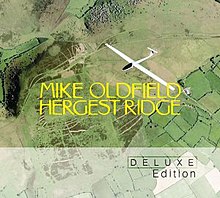The Orchestral Hergest Ridge
| Hergest Ridge | ||||
|---|---|---|---|---|
 |
||||
| Studio album by Mike Oldfield | ||||
| Released | 28 August 1974 | |||
| Recorded | The Manor, spring 1974 | |||
| Genre | Progressive rock | |||
| Length | 40:14 | |||
| Label |
Virgin Mercury (2010 reissue) |
|||
| Producer |
Tom Newman Mike Oldfield |
|||
| Mike Oldfield chronology | ||||
|
||||
| Mercury Records 2010 reissue | ||||

The revised aerial photograph artwork. The Deluxe Edition is shown.
|
||||
| Professional ratings | |
|---|---|
| Review scores | |
| Source | Rating |
| Allmusic | |
| Džuboks | (Mixed) |
Hergest Ridge is the second record album by Mike Oldfield, released in 1974 on Virgin Records. The album was reissued with bonus material and new artwork in June 2010.
During 1973, Oldfield was uncomfortable with the public attention that he had received from the success of Tubular Bells, and retreated to the English countryside to work on his follow-up. The result was Hergest Ridge, named for the hill near Kington, Herefordshire on the border between England and Wales, and near where he was living at the time.
Hergest Ridge entered the UK album charts at number one, only to be displaced by its predecessor, Tubular Bells. Oldfield is thus one of only a few artists (among whom are The Beatles and Bob Dylan) to have defeated themselves in this manner.
Similarly to Tubular Bells, the album is divided into two movements, although Hergest Ridge makes more economical use of its various themes and has more sophisticated musical development than its multi-themed and rapidly changing predecessor. Oldfield is innovative on Hergest Ridge in the novel way in which he builds up complex textures; he frequently superimposes multiple layers of electric guitar recorded by first amplifying heavily (to achieve a sustained organ-like quality) and then reducing the volume greatly via use of the Glorfindel Box and the compression channel from the Manor Mixing Console, as he did on the "Guitars Sounding Like Bagpipes" section from Tubular Bells Part 2. Textures are extended further using various organ timbres and the use of voice as an instrument (the voice is never treated prominently and is deliberately reduced as much as possible and thus permitted largely for textural effect).
According to producer Tom Newman, parts of the album were also recorded at Chipping Norton, and the original release mix created at Air Studios, London.
...
Wikipedia
